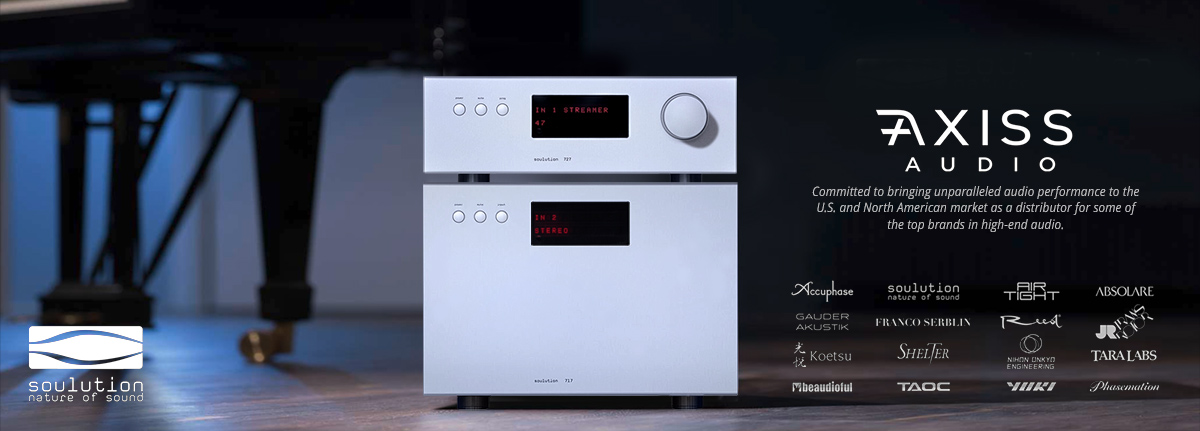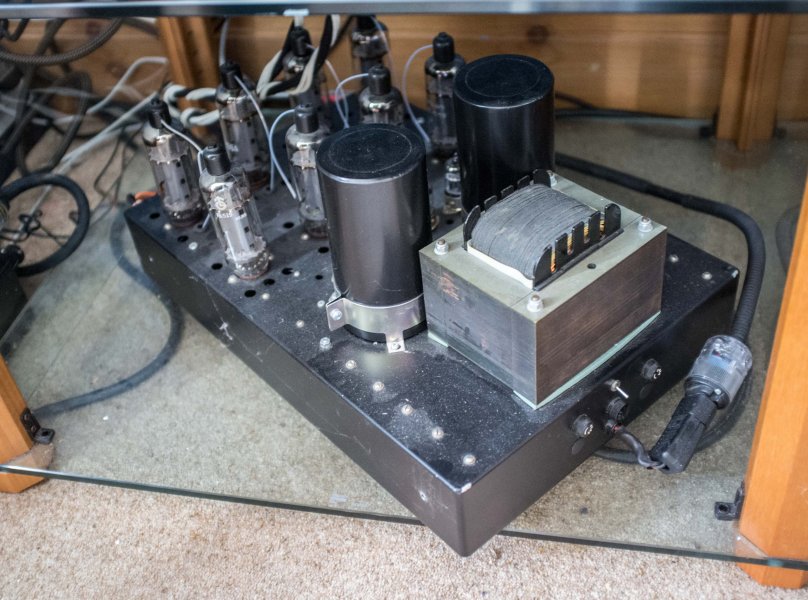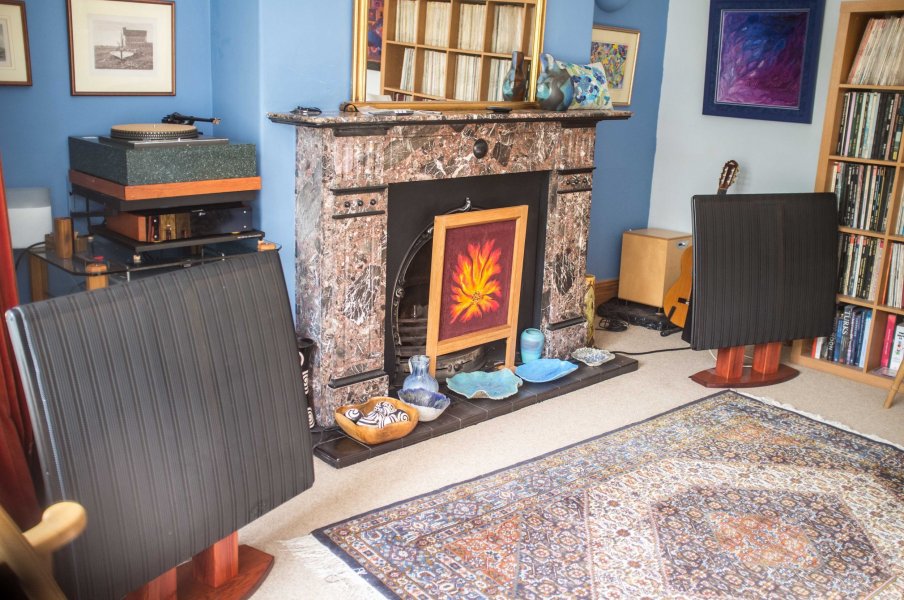I have been using the Croft Series 3 OTL amp for the last two years. These are feeding a pair of QUAD 57 electrostatics. I am really happy with the sound - sounds fantastic to my ears - really lifelike and amazing energy and presence in the music. The amp has had a few issues but Glen Croft lives about an hour from me in the car so he has sorted them out when things went wrong. He recently replaced the original classic transformer with 4 toroidal transformers and the amp now sounds even better. This is going to be my amp of choice now and cannot imagine anything better so I hope I can keep it going for a very long time. Here is a picture of amp before the transformer conversion and the wonderful QUADS, Highly recommended combination!!!!!
Is there an Inherent Leanness to OTL Designs? Does the Speaker have to be Warm for OTLs to Work their Magic?
- Thread starter caesar
- Start date
You are using an out of date browser. It may not display this or other websites correctly.
You should upgrade or use an alternative browser.
You should upgrade or use an alternative browser.
Welcome to WBF, dpgals!
I am sure I would love the sound of your system (as a long-term tubes on electrostatics person)!
I think there is a great deal of comfort in knowing that the manufacturer of your tube amplifier is merely driving distance away.
I am sure I would love the sound of your system (as a long-term tubes on electrostatics person)!
I think there is a great deal of comfort in knowing that the manufacturer of your tube amplifier is merely driving distance away.
Thanks - yes it is very special sound from the system - in terms of supporting kit - Garrard 401 SME V VDH Colibri cartridge, Lector phono stage, Allo Digione signature streamer - ESS Sabre chip DAC of similar quality to a Lampizator Pacific DAC running Roon, AudioPax Series 5 pre, Croft Series 3 OTL, Quad 57 speakers and a REL sub when needed. It all sounds fantastic to my ears. I am just about to upgrade streamer to Lumin U1 streamer.
Regards
David
Regards
David
Agree with much of what has been said about the misconception of OTLs sounding lean.
And yes, to my ears, the level of transparency, detail, and immense open soundstage are truly remarkable in all of audio.
In my case, thank you Ralph of Atma-Sphere
And yes, to my ears, the level of transparency, detail, and immense open soundstage are truly remarkable in all of audio.
In my case, thank you Ralph of Atma-Sphere
Interestingly I sold my Graaf GM20 for that very same reason - buzzing from its transformer. And Graaf is designed and built in Italy, so less excuse than Atmosphere for neglecting to choose componants that won't be humming or buzzing in 240 volt countries!If it was not for the mechanical humming problems of the MA2 power amplifiers used with 50 Hz mains at that time and the heat I would still have considered the Atmasphere option. Unfortunately many excellent US made amplifiers and equipment suffer from this problem and I can't endure with it - some local people are more forgiving than me in this aspect.
The Graph OTLs with adequate speakers were not lean at all - I remember that they were warmer than the MA50.
The heat that tube amps waste is another reason for eventually switching away from tubes altogether - irresponsible in this day and age to use such inefficient devices. The Graaf burns 450 watts at rest. Perhaps Class A is even worse as SS can be made efficient but not by following traditional Class A circuits. Along with internal combusion engines in cars, they'll all be banned (at least in the EU) soon I guess.
@Hear Here You may not have read my response to microstip's post but we got rid of that noise problem in the MA-2 a good ten years ago or more. In addition, our larger amps have output sections that are more efficient, so the tubes don't make as much heat as the tubes do in our smaller amps. This is because more of the power generated by the output section is dissipated in the loudspeaker rather than the output section. This is also why the MA-3 we make (seen earlier in this thread) generates only slightly more heat than the MA-2 of half the power.
Phantom-Audio
Distributor - Indonesia High End
Sorry if im reviving an older thread.
In my experience, the leanness is usually caused by the OTL and Speaker miss match. Running OTL Amps on 16-ohm speakers did not portray the character of being lean or overly thin sounding however using them on an 8ohm or lower impedance speaker sometimes felt overly lean in the midbass region. This all depends on the speaker impedance being relatively flat or harder to drive.
I have been running OTL Amps on both 16 ohm Field Coils speakers(Classic Audio Loudspeakers and Line Magnetic LM3) and always felt the match made in heaven with either, it was a musical setup but the amps are picky with speakers and to get the best out of OTL one really has to make sure the speaker load 8ohms flat or 16ohms.
I also experimented with OTL Amps & Studio Speakers. Quested in particular Which are made in the UK by Roger Quested. His speakers were all mainly 8 ohms flat impedance and the OTL was a great match without the leanness in the midrange or mid-bass. This was another match i enjoyed allot and still do.
The H108 Quested Studio monitors are still by far my most fav speaker for a bookshelf not only for sound but they are incredible value for music playback and are very revealing but fatigue-free.
OTL do sound magical as long as you can match them with the right speakers.
In my experience, the leanness is usually caused by the OTL and Speaker miss match. Running OTL Amps on 16-ohm speakers did not portray the character of being lean or overly thin sounding however using them on an 8ohm or lower impedance speaker sometimes felt overly lean in the midbass region. This all depends on the speaker impedance being relatively flat or harder to drive.
I have been running OTL Amps on both 16 ohm Field Coils speakers(Classic Audio Loudspeakers and Line Magnetic LM3) and always felt the match made in heaven with either, it was a musical setup but the amps are picky with speakers and to get the best out of OTL one really has to make sure the speaker load 8ohms flat or 16ohms.
I also experimented with OTL Amps & Studio Speakers. Quested in particular Which are made in the UK by Roger Quested. His speakers were all mainly 8 ohms flat impedance and the OTL was a great match without the leanness in the midrange or mid-bass. This was another match i enjoyed allot and still do.
The H108 Quested Studio monitors are still by far my most fav speaker for a bookshelf not only for sound but they are incredible value for music playback and are very revealing but fatigue-free.
OTL do sound magical as long as you can match them with the right speakers.
ML CLS was often referred to as lean. I found that to the cause of that impression was i snuffiest amplimer power. Power is what puts flesh on the bones of a speaker.
In genial we tend to subscribe to the notion that, if less is good, none must be better.
OTL tend to be less powerful. This tends to give the impression of a lean speaker.
There is an alternative to OTL. An excellent transformer. This is what VTL does. Doing so allowed them to produce a high-powered tube amp with a transformer.
An OTL will be fine if you mate it with a high impedance and efficient speaker. There are a few excellent ones available.
In genial we tend to subscribe to the notion that, if less is good, none must be better.
OTL tend to be less powerful. This tends to give the impression of a lean speaker.
There is an alternative to OTL. An excellent transformer. This is what VTL does. Doing so allowed them to produce a high-powered tube amp with a transformer.
An OTL will be fine if you mate it with a high impedance and efficient speaker. There are a few excellent ones available.
I have owned non-lean sounding OTLs but they were of the 6c33c variety…didn’t matter the speakers very much with those…just sounded shockingly transparent and liquidSorry if im reviving an older thread.
In my experience, the leanness is usually caused by the OTL and Speaker miss match. Running OTL Amps on 16-ohm speakers did not portray the character of being lean or overly thin sounding however using them on an 8ohm or lower impedance speaker sometimes felt overly lean in the midbass region. This all depends on the speaker impedance being relatively flat or harder to drive.
I have been running OTL Amps on both 16 ohm Field Coils speakers(Classic Audio Loudspeakers and Line Magnetic LM3) and always felt the match made in heaven with either, it was a musical setup but the amps are picky with speakers and to get the best out of OTL one really has to make sure the speaker load 8ohms flat or 16ohms.
I also experimented with OTL Amps & Studio Speakers. Quested in particular Which are made in the UK by Roger Quested. His speakers were all mainly 8 ohms flat impedance and the OTL was a great match without the leanness in the midrange or mid-bass. This was another match i enjoyed allot and still do.
The H108 Quested Studio monitors are still by far my most fav speaker for a bookshelf not only for sound but they are incredible value for music playback and are very revealing but fatigue-free.
OTL do sound magical as long as you can match them with the right speakers.
But too damn hot and too hard to keep biased.
Phantom-Audio
Distributor - Indonesia High End
Novacron from Atma-Sphere was the same, However, the Nirvana were better as long as the speaker matched if not the novacron sounded better on harder loads.I have owned non-lean sounding OTLs but they were of the 6c33c variety…didn’t matter the speakers very much with those…just sounded shockingly transparent and liquid
But too damn hot and too hard to keep biased.
Most OTLs tend to be in the 100 Watt range since they are trying to get a lower output impedance. We started making smaller OTLs on request from our dealers. Personally I didn't think they would work at the time. But that is how our M-60 got started and it turned into one of our best-selling amps.In genial we tend to subscribe to the notion that, if less is good, none must be better.
OTL tend to be less powerful. This tends to give the impression of a lean speaker.
The issue with the CLS (unless its the CLS 1) has always been impedance. About 30 years ago we introduced a device called the 'ZMusic transformer' which was an autoformer that allowed the amp to run at about 12 OHms, with taps for 4,3,2 and 1 Ohms. It had much wider bandwidth than any regular transformer-coupled tube amplifier owing to the very low turns ratio and low inter-winding capacitance. It got eclipsed by the ZERO which was/is made by the Anticables guy (Paul Speltz). We found it easier to sell than the ZMusic solely because it was an aftermarket problem solver- people tended to think of our ZMusic device as tacit admission that our amps didn't drive low impedances (duh...). The fact that there was aftermarket support somehow alleviated that problem. The ZERO has full power bandwidth from about 2Hz to 1 MHz which means it has wider bandwidth than our amps. Normally in a regular tube amp the output transformer is the bandwidth limitation.
Either device meant that the CLS 2 could be used with our amps with great success.
Ugh. It was the CLS one.
I had wanted to pursue beautifully. OTL. Everyone it was a bad idea in part for the reasons you stated. The idea of adding a transformer to an OTL was counter-intuitive .
My next option was a hybird(Moscode 300).For whatever reason, it worked beautifully.
I had wanted to pursue beautifully. OTL. Everyone it was a bad idea in part for the reasons you stated. The idea of adding a transformer to an OTL was counter-intuitive .
My next option was a hybird(Moscode 300).For whatever reason, it worked beautifully.
The CLS 1 needed a bit of power. Customers of ours said it was a match made in heaven. Apparently ML still had parts on hand 10 years ago that allowed one of our customers to build a set up from parts.Ugh. It was the CLS one.
I had wanted to pursue beautifully. OTL. Everyone it was a bad idea in part for the reasons you stated. The idea of adding a transformer to an OTL was counter-intuitive .
My next option was a hybird(Moscode 300).For whatever reason, it worked beautifully.
Its a poor mimic. Another common problem in high end audio is amps that have unmasked higher ordered harmonic distortion (which describes 99% of all solid state amps). The ear perceives this distortion as brightness and it can mimic detail quite well. But I find once you get rid of that problem, you find that distortion has been obscuring detail: the best amps out there are both smooth and detailed at the same time. No brightness.anything that sounds lean will mimick transparency IMO
I think Gayle Sanders made substantial improvements on the CLS 1 before introducing the CLS 2. As legend has it, he had turned his attention to the Sequel /hybrids. The CLS 2 was actually designed by someone else.
I actually had my sights on a MA-1, but the dealer sold it to someone else who had "more compatible speaker."
I actually had my sights on a MA-1, but the dealer sold it to someone else who had "more compatible speaker."
Similar threads
| Steve Williams Site Founder | Site Owner | Administrator | Ron Resnick Site Owner | Administrator | Julian (The Fixer) Website Build | Marketing Managersing |


















